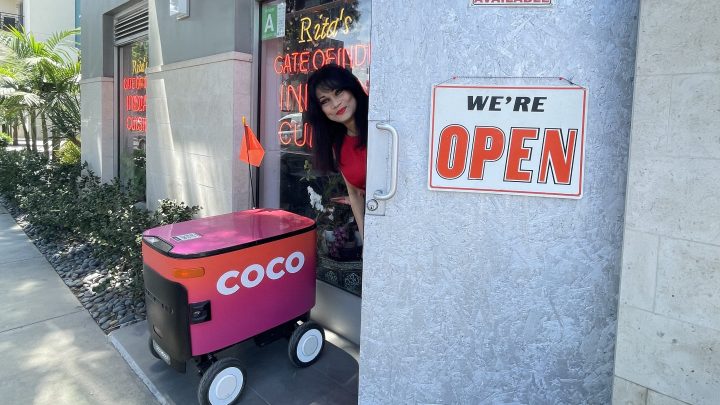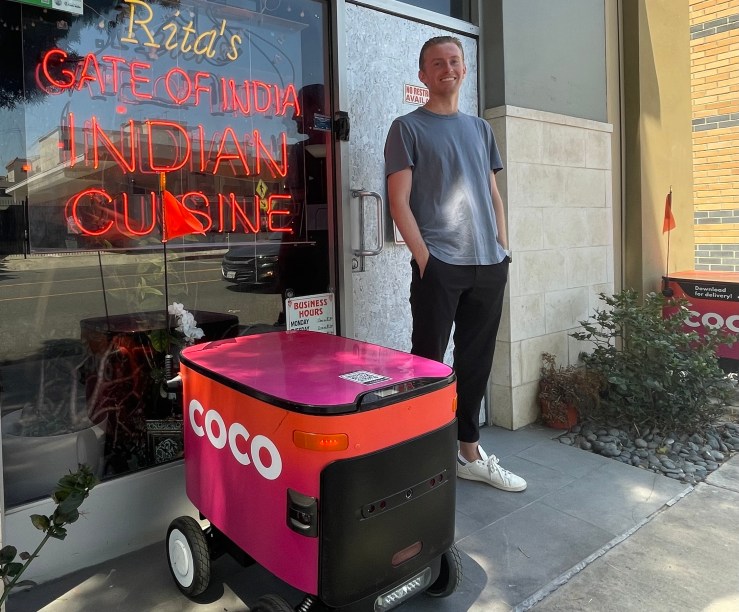
The robot delivering your meal might have a human driver

In Santa Monica, California, pedestrians, electric scooters and other sidewalk users share space with coolers on wheels, zipping restaurant takeout orders to local customers.
“This is Coco,” said Zach Rash, pointing to a pink-and-orange robot parked outside a family-owned Indian restaurant.
Rash and his co-founder, Brad Squicciarini, started developing Coco while they were students at the University of California, Los Angeles. The company, which officially launched in February 2020, has deployed a few thousand robots in Southern California and Texas that can deliver food within 2 miles of restaurants they partner with.
“We looked at a list of cute dog names, and Coco was No. 1,” Rash told “Marketplace” host Kai Ryssdal. “We wanted to come off as very friendly and part of the community.”

Restaurant delivery has exploded over the past few years. According to the National Restaurant Association, 60% of restaurant operators say delivery orders still account for a bigger proportion of sales than before the pandemic.
“A huge chunk of all the deliveries that happen are within a couple of blocks,” Rash said. “And so it doesn’t make sense to be using these cars, which are mainly gas-powered, really old vehicles, to be transporting a couple of pounds of food around the city.”
Food delivery is a crowded industry. In recent years, big companies — from Uber to Domino’s — plus a whole bunch of startups are trying to make it more efficient and profitable with robots.
“But a lot of companies are really focused on autonomy and R&D, and it’s a team of engineers spending, you know, a billion dollars a year [trying] to make this completely autonomous,” Rash said. “We started with remote drivers.”
Human drivers are part of the Coco business model. Employees working from home pilot them through dense urban areas remotely, using Xbox controllers.

“We like people who are good at video games,” Rash said. “So our interview is a video game, we do training in simulators and video games. So it’s a lot of young gamers, and that’s a great demographic to tap into.”
Unlike most driver-based delivery companies, which rely on gig workers, Coco’s robot pilots are trained employees. “Anyone can drive this from home,” Rash said. “That’s a much better job than, you know, being a gig worker.”
Even with human pilots, Coco says robots reduce delivery costs. Since remote workers can easily switch from delivering orders in one area to another, there’s less worker downtime. And since robots are placed at partner restaurants, orders can leave as soon as they’re ready, without waiting for a courier to pick them up.
Rita Huda is the chef and owner at Rita’s Gate of India, one of Coco’s restaurant partners. She told Ryssdal that car-based delivery apps were “running her life.”
Initially she was skeptical when she saw Coco robots in her neighborhood. “I said, ‘Oh, my God! This is like a cartoon! Nobody will take food from this,’” she said. But after trying out the service for a couple of years, she’s been happy with the results. “I’ve got full confidence,” she said.

At this point, Coco’s services are limited. Customers must be within 2 miles of a restaurant Coco serves to use the app. And not every neighborhood is compatible. “You need the right density,” Rash said.
Sidewalk infrastructure poses additional challenges. “Santa Monica is pretty much as good as it gets,” Rash said. “There are curb cuts everywhere, it’s super well lit, sidewalks [are] really well taken care of, so we started here.”
Click the audio player above to hear Kai Ryssdal attempt to pilot one of Coco’s robots.
There’s a lot happening in the world. Through it all, Marketplace is here for you.
You rely on Marketplace to break down the world’s events and tell you how it affects you in a fact-based, approachable way. We rely on your financial support to keep making that possible.
Your donation today powers the independent journalism that you rely on. For just $5/month, you can help sustain Marketplace so we can keep reporting on the things that matter to you.

















